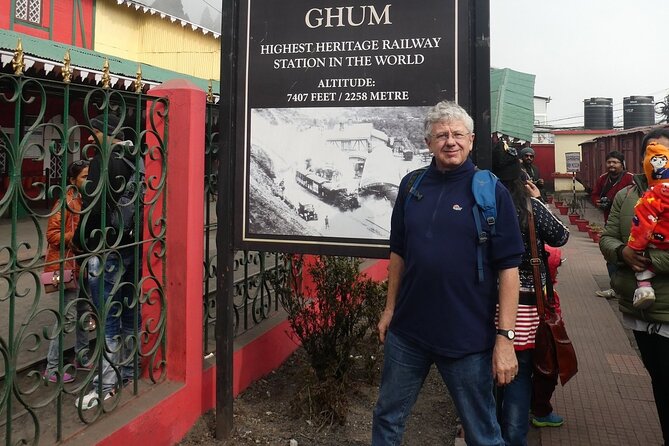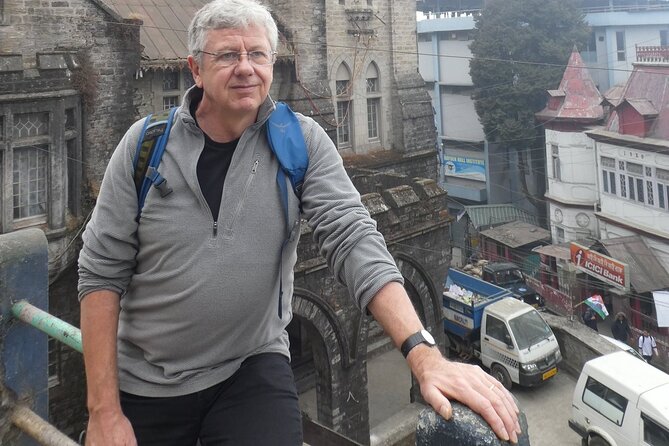Darjeeling’s colonial past continues to captivate visitors from around the world. The Colonial Heritage Walking Tour offers a unique opportunity to take in the city’s storied history. Participants can explore iconic landmarks that whisper tales of the British Raj, from the Darjeeling Tower to the Planters Club. Along the way, they’ll uncover the diverse cultural influences that have shaped this enchanting destination – from its spiritual heritage to its remarkable natural beauty. Whether you’re a history buff or simply seeking to uncover Darjeeling’s hidden gems, this tour promises to provide a fascinating glimpse into the city’s past.
Key Points

- Explore Darjeeling’s colonial past by visiting iconic landmarks like the Darjeeling Tower and Planters Club, offering insights into the region’s British Raj history.
- Gain a holistic understanding of Darjeeling’s spiritual diversity by visiting various temples and churches, including the 19th-century St. Andrew’s Church.
- Enjoy the city’s colonial heritage through vintage photographs, capturing the visual journey of Darjeeling’s cultural and social changes.
- Enjoy panoramic views of the Himalayas and Kanchenjunga range from the historic Keventers restaurant, established in 1927 during the colonial era.
- Discover the blend of colonial and contemporary influences in Darjeeling, with the meeting point at Limbugaon and the end point at the St. Andrew’s Church.
Darjeeling’s Colonial History
Darjeeling’s colonial history dates back to the early 19th century when the British East India Company established a sanatorium in the region to provide a respite for British soldiers and civilians from the sweltering Indian summers.
Over time, the settlement grew, and the British began cultivating tea, which became a significant industry.
Darjeeling’s colonial architecture, including the Planters Club and Gymkhana Club, reflect the city’s British heritage. The colonial influence can also be seen in the city’s churches, such as St. Andrew’s Church, which was built in the Gothic Revival style.
Today, Darjeeling’s colonial past is a key part of its identity and a major draw for visitors seeking to explore the city’s rich history.
You can also read our reviews of more walking tours in Darjeeling
Spiritual Exploration in Darjeeling

Along With its colonial heritage, Darjeeling offers visitors a chance to explore its spiritual side through visits to various temples and churches.
The walking tour includes stops at key religious sites like St. Andrew’s Church, a picturesque Anglican church dating back to the 19th century. Visitors can also see Hindu temples and learn about the diverse faiths that have shaped Darjeeling’s culture.
The tour provides an opportunity to understand the spiritual influences that have coexisted with the city’s colonial past. Through these visits, travelers gain a more holistic appreciation of Darjeeling’s rich history and vibrant communities.
Tour Highlights: Iconic Landmarks

Amidst Darjeeling’s colonial-era landmarks, the walking tour showcases several iconic sites that capture the city’s rich heritage.
Visitors are treated to a glimpse of the Darjeeling Tower, a prominent structure dating back to the British Raj era.
The tour also includes visits to the Darjeeling Planters Club and Darjeeling Gymkhana Club, which were once social hubs for the colonial elite.
Especially noteworthy is the opportunity to see old photographs of the city at one of the oldest studios, providing a fascinating window into Darjeeling’s past.
Atop the iconic Keventers restaurant, travelers can enjoy panoramic views of the surrounding landscape, completing this immersive exploration of Darjeeling’s colonial heritage.
Visiting Darjeeling Planters Club
The Darjeeling Planters Club, once a social hub for the colonial elite, offers visitors a glimpse into the city’s rich heritage during the walking tour.
This grand Victorian-style building was the gathering place for the British tea plantation owners and administrators in the early 20th century.
Tourists can admire the club’s elegant architecture, including its ornate facade and well-manicured gardens. Inside, they’ll find tasteful decor and vintage furnishings that transport them back in time.
The tour guide provides insights into the club’s history and the role it played in Darjeeling’s colonial past. Visitors can imagine the lively social events and discussions that once took place within these walls, offering a unique perspective on the city’s colonial legacy.
Capturing Darjeeling’s Heritage Visually
One of the highlights of the Colonial Heritage Walking Tour in Darjeeling is the opportunity for visitors to see old photos of the city at one of the oldest studios. This visual journey through Darjeeling’s past allows guests to capture the essence of its colonial heritage.
The tour guide shares fascinating stories behind these historic images, painting a vivid picture of the city’s transformation over time.
Visitors can expect to:
- View captivating photographs showcasing Darjeeling’s colonial-era architecture and landmarks
- Learn about the evolution of photography in the region and its importance in preserving local history
- Gain a deeper understanding of Darjeeling’s cultural and social changes through the lens of vintage photographs
Keventers Restaurant and City Views
Prominently situated within the tour, visitors often marvel at the iconic Keventers restaurant, which offers captivating views of Darjeeling’s stunning vistas.
This historic eatery, established in 1927, has become a beloved landmark in the city, known for its charming colonial-era ambiance and delectable fare.
From the restaurant’s windows, guests can take in panoramic views of the majestic Himalayas, including the iconic Kanchenjunga range. This vantage point allows for an unparalleled appreciation of Darjeeling’s natural beauty and the city’s rich colonial heritage.
Whether savoring a cup of the region’s renowned tea or indulging in a hearty meal, visitors to Keventers can revel in the unique blend of history, scenery, and culinary delights that make this tour a truly immersive experience.
Meeting and End Point Details
The tour begins at Limbugaon, Darjeeling, where participants gather at the meeting point specified on their booking confirmations.
After exploring the city’s colonial landmarks, the tour culminates at St. Andrews Church in the Chauk Bazaar area of Darjeeling.
The meeting and end points are strategically chosen to provide a comprehensive experience of Darjeeling’s colonial heritage:
- The Limbugaon meeting point is conveniently located, making it accessible for travelers.
- St. Andrews Church, the end point, is a significant colonial-era structure that caps off the tour’s exploration of Darjeeling’s rich history.
- The route between the two points allows participants to witness the city’s blend of colonial and contemporary influences.
Tour Logistics and Information
Typically, the Colonial Heritage Walking Tour in Darjeeling provides confirmation to participants upon booking. The tour isn’t wheelchair accessible but does allow service animals.
Travelers can access the tour easily via nearby public transportation, though infants must sit on laps during the experience. The group size is limited to a maximum of 50 travelers.
The tour takes visitors on a journey through Darjeeling’s colonial past, highlighting key landmarks like the Darjeeling Tower, Darjeeling Planters Club, Darjeeling Gymkhana Club, and St. Andrews Church.
Along the way, participants have the opportunity to see old photographs of the city at one of the oldest studios and take in the breathtaking views from the iconic Keventers restaurant.
Frequently Asked Questions
Is the Tour Accessible for People With Disabilities?
The tour is not wheelchair accessible, but service animals are allowed. Strollers can access the tour. Visitors with disabilities should contact the tour operator to discuss their needs and accommodation options.
Can I Bring My Pet Dog on the Tour?
The tour does not allow service animals or pets. The listing specifies that "service animals allowed" but does not mention bringing personal pets. Participants should plan to leave their dogs at home for this walking tour.
Is There an Option to Join the Tour at a Different Location?
Yes, there is an option to join the tour at a different location. The tour description indicates the meeting point is Limbugaon, but the end point is St. Andrews Church, so participants can join at either location.
Are There Any Age Restrictions for the Tour Participants?
The tour doesn’t have any age restrictions. Children of all ages are welcome, though infants must sit on laps. The maximum group size is 50 travelers, so the tour can accommodate both families and solo travelers.
What Is the Maximum Group Size for This Tour?
The tour has a maximum group size of 50 travelers. According to the additional information provided, the tour can accommodate a maximum of 50 participants.
Recap
The Colonial Heritage Walking Tour in Darjeeling offers a captivating glimpse into the city’s rich colonial past.
Visitors can explore iconic landmarks, discover spiritual sites, and enjoy panoramic city views – all while gaining a deeper understanding of Darjeeling’s diverse cultural influences.
Whether you’re interested in history, architecture, or natural beauty, this tour provides a holistic experience that showcases the unique blend of elements that make Darjeeling a truly special destination.
More Walking Tours in Darjeeling
More Tours in Darjeeling
More Tour Reviews in Darjeeling
Not for you? Here's more nearby things to do in Darjeeling we have reviewed
- Group Adventure Darjeeling Gangtok | FREE Toy Train Ride
- 8 Best Tours In Darjeeling
- 9 Best Guided Tours In Darjeeling
- Day Trip to Singalila (Guided Private Sightseeing Experience From Darjeeling)
- Darjeeling Tea Garden Tour
- 10 Best Treks And Hiking Tours In Darjeeling
- 2 Best Historical Tours In Darjeeling
- The Land Mark Tour (Nautical Day Darjeeling to Mirik Crusade)
- The Gangtok City Walk
- Darjeeling: Tiger Hill Sunrise Hike – Guided Day Trip
- Darjeeling Tonglu Tumling Day Hiking
- Darjeeling Senchal Wildlife Sanctuary Sonada Hike – 1 Day
